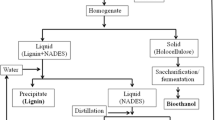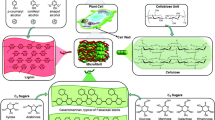Abstract
The possibility to utilize fiber sludge, waste fibers from pulp mills and lignocellulose-based biorefineries, for combined production of liquid biofuel and biocatalysts was investigated. Without pretreatment, fiber sludge was hydrolyzed enzymatically to monosaccharides, mainly glucose and xylose. In the first of two sequential fermentation steps, the fiber sludge hydrolysate was fermented to cellulosic ethanol with the yeast Saccharomyces cerevisiae. Although the final ethanol yields were similar, the ethanol productivity after 9.5 h was 3.3 g/l/h for the fiber sludge hydrolysate compared with only 2.2 g/l/h for a reference fermentation with similar sugar content. In the second fermentation step, the spent fiber sludge hydrolysate (the stillage obtained after distillation) was used as growth medium for recombinant Aspergillus niger expressing the xylanase-encoding Trichoderma reesei (Hypocrea jecorina) xyn2 gene. The xylanase activity obtained with the spent fiber sludge hydrolysate (8,500 nkat/ml) was higher than that obtained in a standard medium with similar monosaccharide content (1,400 nkat/ml). Analyses based on deglycosylation with N-glycosidase F suggest that the main part of the recombinant xylanase was unglycosylated and had molecular mass of 20.7 kDa, while a minor part had N-linked glycosylation and molecular mass of 23.6 kDa. Chemical analyses of the growth medium showed that important carbon sources in the spent fiber sludge hydrolysate included xylose, small aliphatic acids, and oligosaccharides. The results show the potential of converting waste fiber sludge to liquid biofuel and enzymes as coproducts in lignocellulose-based biorefineries.





Similar content being viewed by others
References
Alriksson B, Rose SH, van Zyl WH, Sjöde A, Nilvebrant N-O, Jönsson LJ (2009) Cellulase production from spent lignocellulose hydrolysates by recombinant Aspergillus niger. Appl Environ Microbiol 75:2366–2374
Bailey M, Buchert JJ, Viikari L (1993) Effect of pH on production of xylanase by Trichoderma reesei on xylan-based and cellulose-based media. Appl Microbiol Biotechnol 40:224–229
Fan Z, South C, Lyford K, Munsie J, van Walsum P, Lynd LR (2003) Conversion of paper sludge to ethanol in a semicontinuous solids-fed reactor. Bioprocess Biosyst Eng 26:93–101
He J, Yu B, Zhang K, Ding K, Chen D (2009) Expression of endo-1, 4-beta-xylanase from Trichoderma reesei in Pichia pastoris and functional characterization of the produced enzyme. BMC Biotechnol 9:56
Image J (2010) Available from: rsb.info.nih.gov/ij. Accessed 17 Apr 2010
Jeffries TW, Schartman R (1999) Bioconversion of secondary fiber fines to ethanol using counter-current enzymatic saccharification and co-fermentation. Appl Biochem Biotechnol 77–79:435–444
Kádár Z, Szengyel Z, Réczey K (2004) Simultaneous saccharification and fermentation (SSF) of industrial wastes for the production of ethanol. Ind Crop Prod 20:103–110
La Grange DC, Pretorius IS, van Zyl WH (1996) Expression of a Trichoderma reesei β-xylanase gene (XYN2) in Saccharomyces cerevisiae. Appl Environ Microbiol 62:1036–1044
Lappalainen A, Siika-Aho M, Kalkkinen N, Fagerström R, Tenkanen M (2000) Endoxylanase II from Trichoderma reesei has several isoforms with different isoelectric points. Biotechnol Appl Biochem 31:61–68
Lark N, Xia Y, Qin C-G, Gong CS, Tsao GT (1997) Production of ethanol from recycled paper sludge using cellulase and yeast Kluveromyces marxianus. Biomass Bioenerg 12:135–143
Meyer V (2008) Genetic engineering of filamentous fungi—progress, obstacles and future trends. Biotechnol Adv 26:177–185
Parkinson M, Wainwright M, Killham K (1989) Observations on oligotrophic growth of fungi on silica gel. Mycol Res 93:529–534
Polizeli ML, Rizzatti AC, Monti R, Terenzi HF, Jorge JA, Amorim DS (2005) Xylanases from fungi: properties and industrial applications. Appl Microbiol Biotechnol 67:577–591
Ragauskas AJ, Nagy M, Kim DH, Eckert CA, Hallett JP, Liotta CL (2006) From wood to fuels: integrating biofuels and pulp production. Ind Biotechnol 2:55–65
Rose SH, van Zyl WH (2002) Constitutive expression of the Trichoderma reesei beta-1, 4-xylanase gene (xyn2) and the beta-1, 4-endoglucanase gene (egI) in Aspergillus niger in molasses and defined glucose media. Appl Microbiol Biotechnol 58:461–468
Sixta H, Süss H-U, Potthast A, Schwanninger M, Krotscheck AW (2006) Pulp bleaching. In: Sixta H (ed) Handbook of pulp, vol 2. Wiley, Weinheim, pp 818–822
Sjöde A, Alriksson B, Jönsson LJ, Nilvebrant N-O (2007) The potential in bioethanol production from waste fiber sludges in pulp mill-based biorefineries. Appl Biochem Biotechnol 136–140:327–338
Stals I, Sandra K, Geysens S, Contreras R, Van Beeumen J, Claeyssens M (2004) Factors influencing glycosylation of Trichoderma reesei cellulases. I: postsecretorial changes of the O- and N-glycosylation pattern of Cel7A. Glycobiology 14:713–724
Steinberg TH, Haugland RP, Singer VL (1996) Applications of SYPRO orange and SYPRO red protein gel stains. Anal Biochem 239:238–245
Takashima S, Nakamura A, Hidaka M, Masaki H, Uozumi T (1999) Isolation and characterization of the actin gene from the cellulolytic fungus Humicola grisea and analysis of transcription levels of actin and cellulase genes. J Biochem 125:728–736
Verdoes JC, Punt PJ, van den Hondel CAMJJ (1995) The complete karyotype of Aspergillus niger: the use of introduced electrophoretic mobility variation of chromosomes for gene assignment studies. Appl Microbiol Biotechnol 43:195–205
Wainwright M, Al-Wajee K, Grayston SJ (1997) Effect of silicic acid and other silicon compounds on fungal growth in oligotrophic and nutrient-rich media. Mycol Res 101:933–938
Webb L (1994) Sludge disposal: the unregulated loophole. Pulp Paper 36:18–23
Acknowledgments
The assistance of Marcus Jonsson in performing preliminary experiments is gratefully acknowledged. One of the authors (A.C.) was supported by SEKAB E-Technology (Örnsköldsvik, Sweden) through the Umeå University Industrial Post Graduate School. The research received financial support from the Kempe Foundations, the Knut and Alice Wallenberg Foundation, the Biorefinery of the Future (www.bioraffinaderi.se), and the Bio4Energy research initiative (www.bio4energy.se).
Author information
Authors and Affiliations
Corresponding author
Rights and permissions
About this article
Cite this article
Cavka, A., Alriksson, B., Rose, S.H. et al. Biorefining of wood: combined production of ethanol and xylanase from waste fiber sludge. J Ind Microbiol Biotechnol 38, 891–899 (2011). https://doi.org/10.1007/s10295-010-0856-9
Received:
Accepted:
Published:
Issue Date:
DOI: https://doi.org/10.1007/s10295-010-0856-9




